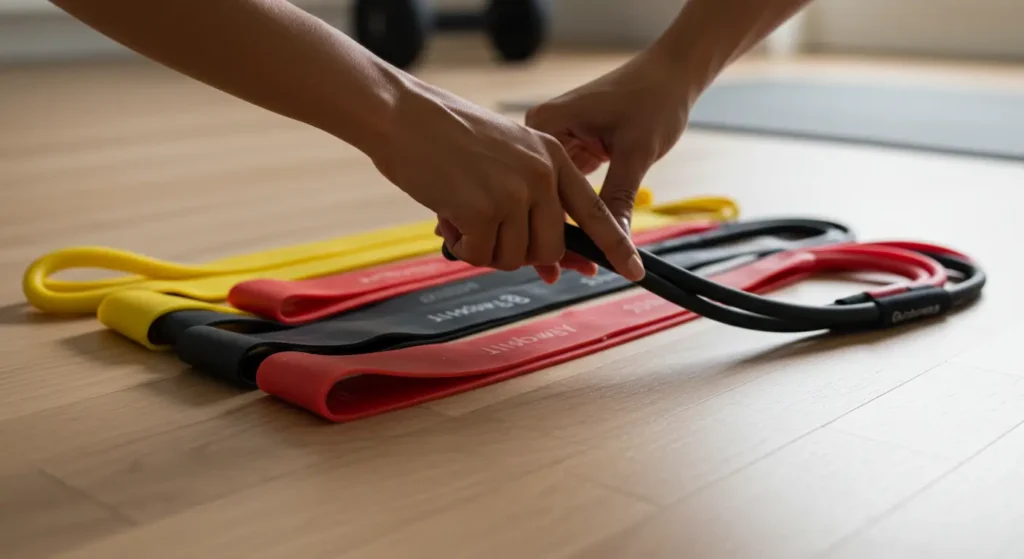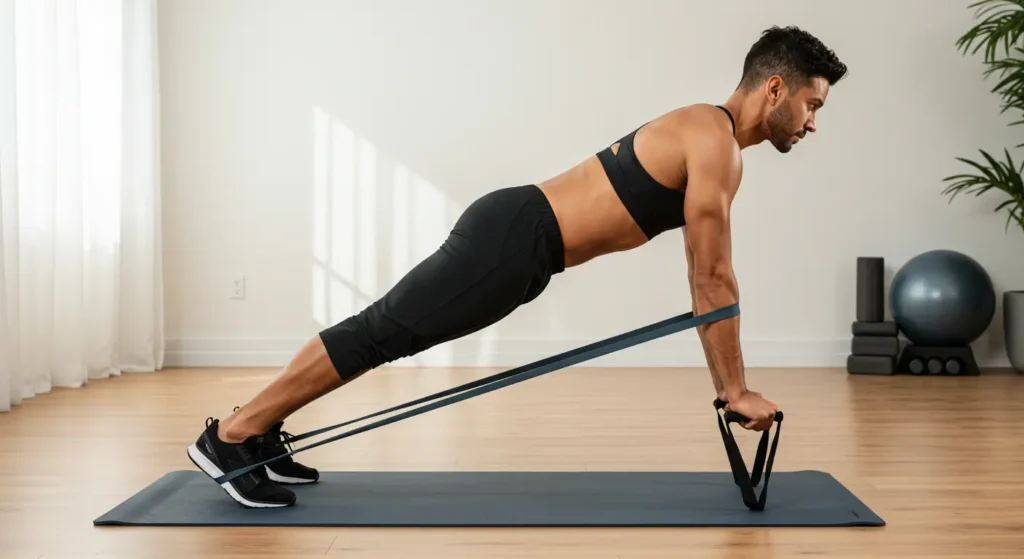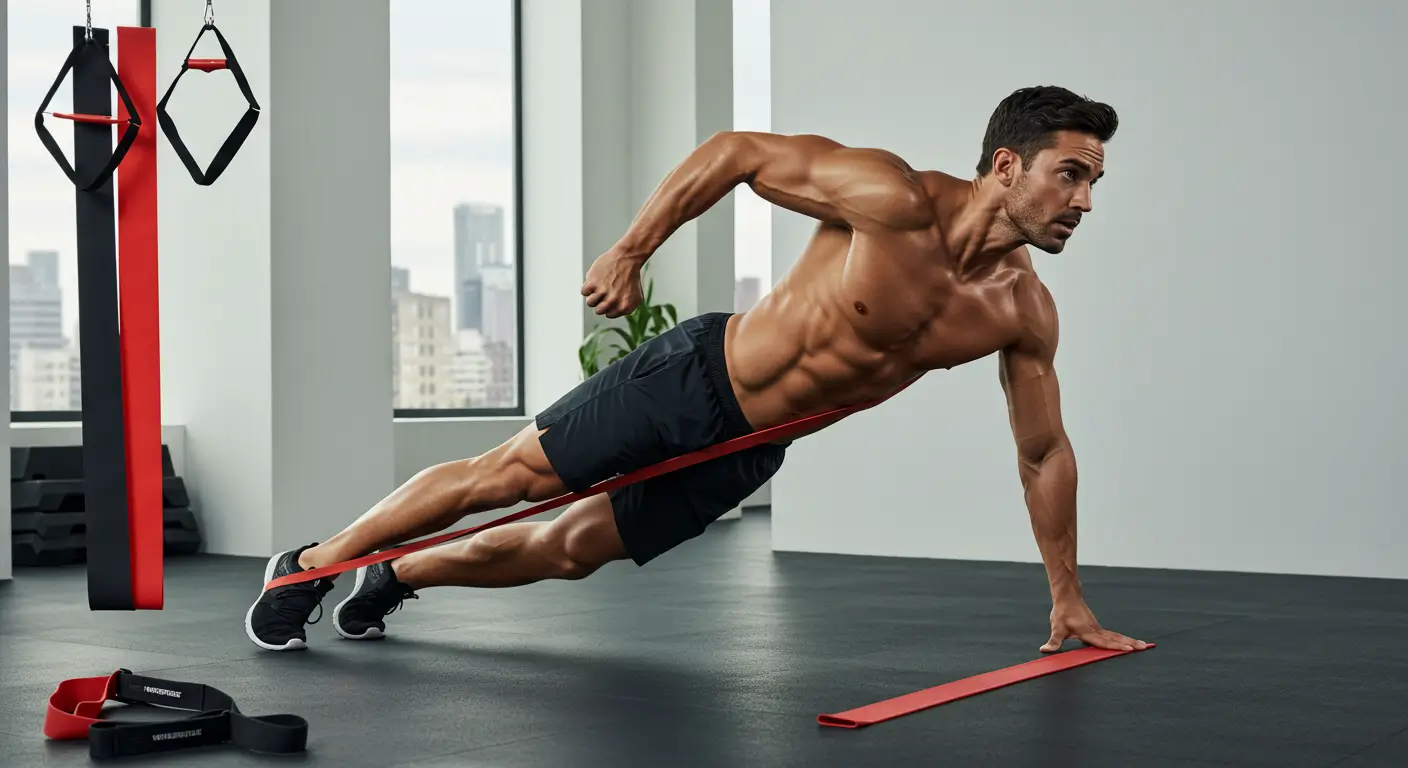Ever wonder if your ab routine could be more effective? Are you tired of endless crunches that just don’t seem to deliver the results you’re chasing? If you’re looking to truly transform your core strength and achieve better definition, it’s time to discover a game-changer: ab workout using resistance bands works better than many traditional methods. These versatile tools offer a unique advantage, providing constant tension that deeply engages your abdominal muscles in ways bodyweight exercises simply can’t. We’ll dive into the science behind why bands are so effective, explore essential exercises, and share practical tips to maximize your core gains. Get ready to elevate your fitness journey and sculpt a stronger, more stable core right from home!
Table of Contents
The Scientific Edge: Why Resistance Bands Revolutionize Your Ab Workout

H3: Unleashing Constant Tension: The Secret of Accommodating Resistance
Have you ever done a crunch and felt like there’s a “dead spot” where your muscles aren’t really working? Or lifted a dumbbell, feeling the resistance only at certain points in the movement? That’s where the magic of resistance bands comes in, and it’s a huge reason why an ab workout using resistance bands works better for consistent muscle activation. The secret lies in something called “accommodating resistance.”
Unlike traditional weights where gravity provides a fixed resistance, resistance bands offer increasing tension as they stretch. This means that as you extend or contract during an ab exercise, the band provides more challenge throughout the entire range of motion. Imagine a leg raise: with a dumbbell, the bottom might feel easy, and the top harder. With a band, you’re fighting resistance from start to finish! This constant tension forces your abdominal muscles to stay engaged and work harder through every single inch of the movement. Personally, I noticed a significant difference in how “fired up” my core felt once I started incorporating bands – it was like every fiber was finally getting its moment to shine. This leads to more efficient muscle stimulus and ultimately, more effective core strength gains.
User Engagement: Have you noticed a difference in muscle engagement when using bands versus bodyweight for your core exercises?
H3: Beyond Crunching: How Bands Target Every Core Muscle

When people think of an “ab workout,” they often picture endless crunches targeting just the “six-pack” muscles. But your core is so much more than just the rectus abdominis! It’s a complex network of muscles, including your obliques (sides) and the deep transverse abdominis (your natural corset), all vital for stability, posture, and preventing injuries. And here’s why an ab workout using resistance bands works better for hitting all these crucial areas.
Resistance bands excel at providing resistance in multiple planes of motion – not just up and down. This versatility allows you to perform rotational, anti-rotational, and anti-extension movements that are incredibly effective for comprehensive core muscle activation. Think about a Pallof Press, which directly targets your transverse abdominis and obliques by forcing them to resist rotation. Or banded wood chops that engage your entire core in a twisting motion. My clients often express surprise at how deeply they feel their core working during these types of resistance band ab exercises, realizing they’d neglected entire muscle groups with their old routines. By engaging these often-overlooked muscles, you’re not just building a stronger midsection; you’re developing true core stability that supports your spine and enhances your functional strength for everyday life.
H3: Progressive Overload Made Easy for Stronger Abs
One of the fundamental principles of building muscle and increasing strength is progressive overload – consistently challenging your muscles more over time. If you do the same ab workout day in and day out, your body adapts, and your progress plateaus. This is where resistance bands shine, making progressive overload made easy for stronger abs, without needing a gym full of heavy equipment.
Think about it: with bodyweight exercises, increasing the challenge can mean doing more reps, which isn’t always efficient, or complex variations that might be too difficult. With resistance bands, scaling up your workout intensity is incredibly straightforward. You can simply grab a band with a higher resistance level, use two bands at once, or even combine a band with a bodyweight exercise to add extra challenge. For example, if banded leg raises become too easy, you simply switch to a thicker band. This seamless progression ensures your abdominal muscles are always stimulated to grow and adapt. It’s an incredibly empowering feeling to know you can continuously challenge yourself, leading to significant and sustained core strength improvements right in your living room. An ab workout using resistance bands works better because it gives you that clear path to getting stronger, day after day.
Maximizing Your Core Gains: Practical Ab Workouts with Resistance Bands
Now that we’ve explored the scientific advantages of using resistance bands for your core, let’s get practical. Understanding why an ab workout using resistance bands works better is just the first step; the real magic happens when you incorporate these versatile tools into your routine effectively. This section will guide you through essential exercises and smart strategies to maximize your core gains.
H3: Essential Resistance Band Ab Exercises for a Sculpted Midsection
Ready to put those bands to work and truly feel your abdominal muscles engage? Forget the endless, ineffective crunches; resistance bands unlock a whole new world of movements that comprehensively target every part of your core. This is where an ab workout using resistance bands works better for achieving that sculpted midsection and deep core strength.
Let’s dive into some powerhouse resistance band ab exercises that you can easily integrate into your routine:
- Pallof Press: This is an anti-rotation gem that lights up your deep transverse abdominis and obliques. Anchor a band at chest height, stand perpendicular to it, and press the band straight out, resisting the urge to twist. It’s fantastic for core stability!
- Banded Crunches/Leg Raises: Loop a band around your feet for crunches or over your feet (anchored overhead) for leg raises. The constant tension throughout the movement makes these classic exercises far more challenging and effective for your rectus abdominis.
- Resistance Band Russian Twists: Add a band to your traditional Russian twists by holding one end and anchoring the other. The added resistance forces your obliques to work harder as you rotate, leading to greater muscle engagement.
- Banded Dead Bugs/Plank Rows: For deeper core work, try a banded dead bug, where you resist the band pulling your limbs. Or, in a plank position, perform rows with a band anchored in front, challenging your entire core to prevent rotation.
These are just a few examples, but they demonstrate the incredible workout versatility that resistance bands offer for your core. My personal favorite is the Pallof Press because it truly makes you feel your deep core working to stabilize, which traditional ab exercises often miss.
User Engagement: What’s your favorite resistance band ab exercise that you’ve tried, or which one are you most excited to add to your routine?
H3: Integrating Bands: From Warm-up to Advanced Core Routines
The beauty of resistance bands isn’t just in the individual exercises; it’s how seamlessly they can be woven into your entire fitness routine. Whether you’re a beginner just starting your core strength journey or an experienced lifter looking to level up, learning to integrate bands means an ab workout using resistance bands works better for every stage.
Don’t just jump straight into your heaviest band! Start with a light band for dynamic warm-ups to activate your core muscles before your main workout. Think banded marching in place or gentle torso twists to prepare your abdominal muscles. For your core-focused sessions, you can dedicate a full ab workout using resistance bands, choosing 3-5 of your favorite exercises and performing 2-3 sets of 10-15 reps. For those looking to push further, integrate bands into compound movements like squats or deadlifts to add extra core stability challenge, or use them to make advanced core exercises even tougher. They’re also fantastic for active recovery or even travel workouts, turning any hotel room into a personal gym. I often find myself packing a few bands for trips, ensuring I can maintain my core routine no matter where I am.
H3: Avoiding Common Pitfalls for Optimal Resistance Band Ab Results
While an ab workout using resistance bands works better in many ways, just like any exercise, there are common mistakes that can hinder your progress or even lead to discomfort. To get truly optimal resistance band ab results and ensure injury prevention, paying attention to your form and approach is key.
One of the most frequent errors is choosing a band that’s too heavy too soon. If you’re struggling to complete a full range of motion with good form, the band is likely too strong. It’s always better to start with lighter resistance and focus on muscle engagement and control. Another pitfall is letting the band “snap” back or losing control during the eccentric (lowering) phase of an exercise. Remember, constant tension is your goal, so control both the lengthening and shortening of the band. I’ve seen many people rush through reps, missing out on half the benefits! Also, don’t forget to maintain a strong core stability throughout your exercises; avoid arching your back or letting your hips sag during planks or anti-rotation movements. Always prioritize proper form over the amount of resistance. By being mindful of these simple tips, you’ll harness the full power of your resistance band ab workout and truly elevate your core strength safely and effectively.
Why is an ab workout using resistance bands considered more effective than bodyweight exercises?
Resistance bands provide constant tension throughout the entire range of motion, which is often lacking in bodyweight exercises. This continuous resistance forces your core muscles to work harder and more consistently, leading to greater muscle engagement, increased strength, and better definition. They also allow for targeted resistance from various angles, activating more muscle fibers
Can beginners effectively do an ab workout using resistance bands?
Absolutely! Resistance bands come in various resistance levels, making them suitable for all fitness levels, including beginners. Starting with lighter bands allows you to master proper form and gradually build strength. As you progress, you can move to bands with higher resistance to continue challenging your core.
What are the best types of resistance bands for an ab workout using resistance bands?
Loop bands (mini-bands) and tube bands with handles are both excellent for ab workouts. Loop bands are great for exercises like banded dead bugs or glute bridges with core engagement. Tube bands with handles offer more versatility for movements like Pallof presses, wood chops, and banded crunches. A set with varying resistance levels will provide the most flexibility.
How often should I perform an ab workout using resistance bands?
For optimal results, aim for 2-4 sessions per week, allowing for a day of rest in between to enable muscle recovery and growth. Listen to your body and adjust the frequency based on your recovery rate and fitness goals. Consistency is key to seeing significant improvements in your core strength and aesthetics.
Can an ab workout using resistance bands help with lower back pain?
Yes, strengthening your core, including the deep abdominal muscles, is crucial for supporting your spine and alleviating lower back pain. Resistance bands allow for controlled, precise movements that can specifically target and strengthen these stabilizing muscles, improving overall core stability and reducing strain on your lower back. Always consult with a healthcare professional before starting any new exercise regimen if you have pre-existing pain.


